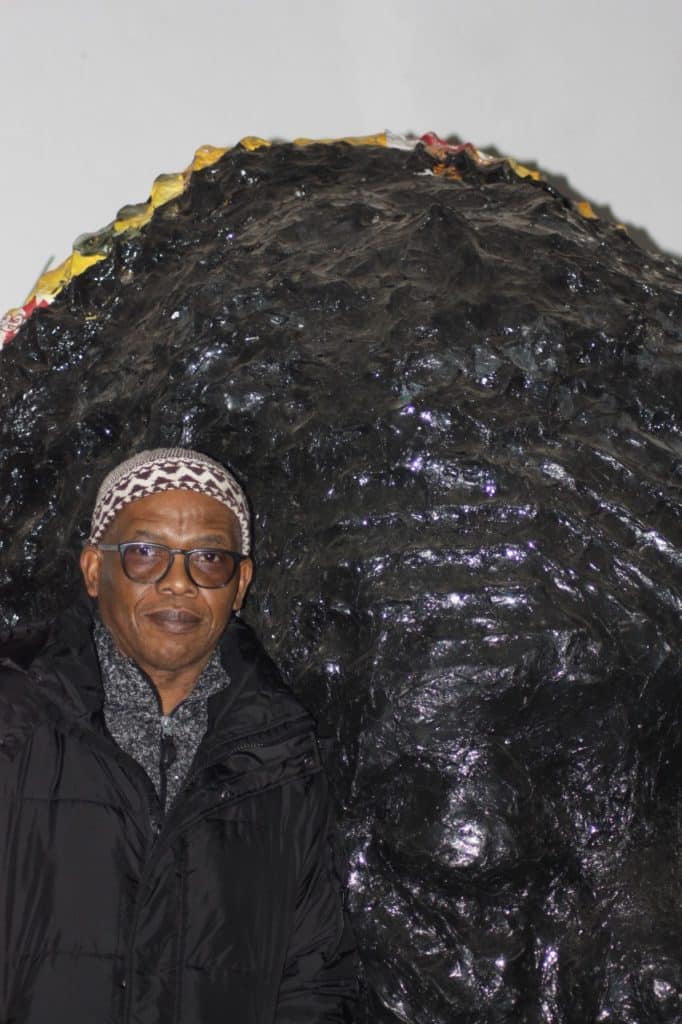Mbongeni Buthelezi’s fascination with turning discarded materials into meaningful art is evident, and his creative sanctuary is a testament to his unwavering dedication.
It is the middle of July in South Africa and everyone is dressed head to toe in full winter gear, including Mbongeni Buthelezi as he opens the entrance to his studio for me.
The immediate assumption one makes at this point is “oh no, it’s going to an ice cold studio”. However, as you walk in, you are greeted with a large warehouse space with expansive windows allowing a good amount of sunlight into the building. These allow Buthelezi to see his work accurately and also provide the space with a welcoming source of heat. The heat guns that Buthelezi and his assistant have going to apply the plastic to the canvas of his latest piece also provide an element of warmth as they had clearly been doing this for the previous few hours.
The studio itself is a haven of transformation. As one enters, the artistic journey that Buthelezi has embarked upon becomes palpable. The creations within are diverse and captivating, ranging from pieces that could be mistaken for oil or watercolor paintings to sculptures that stretch over seven feet in height, even extending to custom-designed dining tables. Buthelezi’s fascination with turning discarded materials into meaningful art is evident, and his creative sanctuary is a testament to his unwavering dedication.
When asked about his journey as an artist, Buthelezi’s response is: “This is my whole life. For me, it all really began in 1985 when I first stepped into an art class. By 1992, I had transitioned from part-time exploration to full-time immersion into this art thing.”
Loading...

The years that followed were filled with growth, marked by the completion of an art teaching course and exploration of teaching art. As his commitment to his craft deepened, he navigated the realms of both artistic creation and education. However, due a few stubborn students he encountered along the way, the decision to take his art career into the realm of an independent artist was made all that much easier. He reflects: “Animals are dying, fish in the ocean are dying – because of this material and because of us as human beings. It is us that need to take responsibility.”
Buthelezi’s early years at art school as an artist are interwoven with the exploration of varied techniques. His journey as a student introduced him to a rich array of artistic methods, each of which contributed to the evolution of his craft. The culmination of these experiences granted him a versatile toolkit that enriched his artistic expression. A pivotal moment was a call for innovation, a desire to create something uniquely his own. The scarcity of resources, combined with financial constraints, propelled him to seek alternative media. Fueled by an ambition to break free from conventional artistic pathways, Buthelezi embarked on experimentation.
Buthelezi says: “There was a time that I once thought I need a change, I need to do something that would be unique and what was that going to be? At the beginning I had no money to buy paint, I didn’t really have enough money to make ends meet, to be honest. So I began to seriously look around and see what I could possibly do to be able to proceed with whatever it was that I wanted to achieve.”
By the 1990s, Buthelezi had cemented his status as a professional artist, channeling his craft to advocate for a healthier planet. His artworks, born from recycled plastics, encapsulate the essence of growing up in South African townships. Over the course of his career, he has harnessed art as a potent tool for education, sparking dialogues about the global menace of plastic pollution. He boldly asserts that the contemporary world offers abundant resources for art creation without necessitating additional manufacturing.
“Honestly my work has been displayed in exhibitions, festivals, workshops which have taken me to all kinds of places. Germany and Australia were two of my favorites. Vermont in Canada was amazing but very cold!” These exhibitions showcased the universality of his message. His art functions as a mirror reflecting societal realities, prompting discussions on pressing issues. “Last year I engaged in a discussion on plastic innovation at the South African National Science and Technology Forum. Later in the year, I was set to participate in an art and environment festival in Abu Dhabi.”

Amidst the acclaim, Buthelezi has encountered sceptics questioning the sustainability of his
technique due to the eventual depletion of plastic resources. “However, I welcome this outcome as it really does align with my work’s purpose which is highlighting the true urgency of plastic pollution in the world.”
In his ongoing journey, Buthelezi not only creates art but also fosters conversations and inspires change, which in his opinion is the purpose of art. As he prepares for engagements and exhibitions, his commitment to being an artist mirrors society and stands as a testament to the transformative power of creativity. The fusion of innovation, environmental consciousness, and advocacy underscores the significance of his work in addressing global challenges. He combines artistic expression with environmental advocacy, using recycled plastics.
His art sparks dialogues on plastic pollution globally. His work is a testament to the transformative power of creativity, addressing global challenges through innovation and advocacy. A truly visionary man being the change in the world that he wants to see. Maybe we could all take a little something from that.
Loading...
